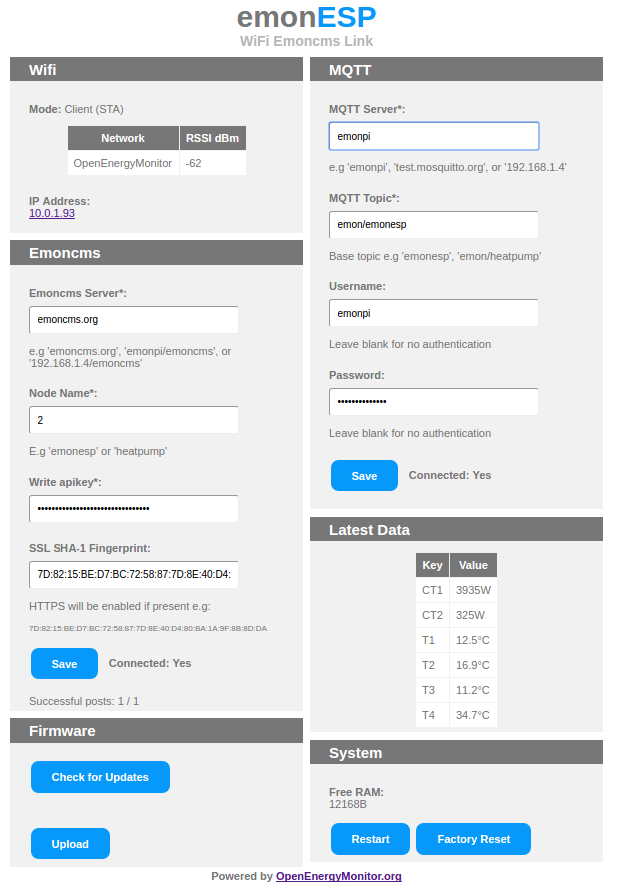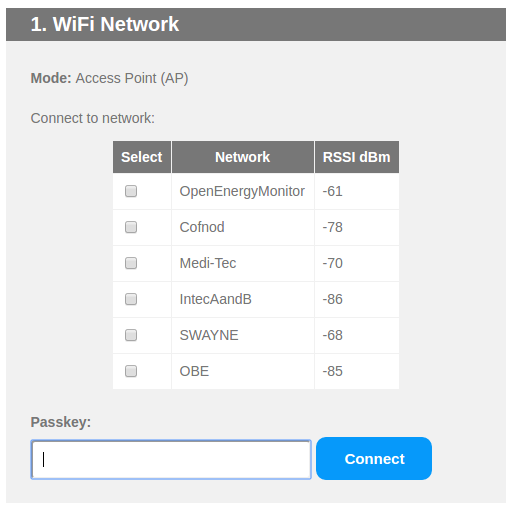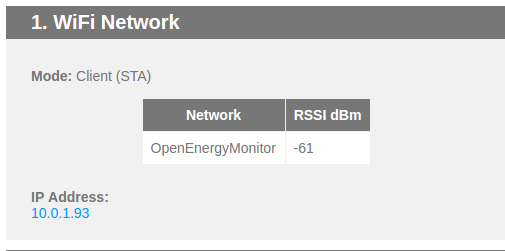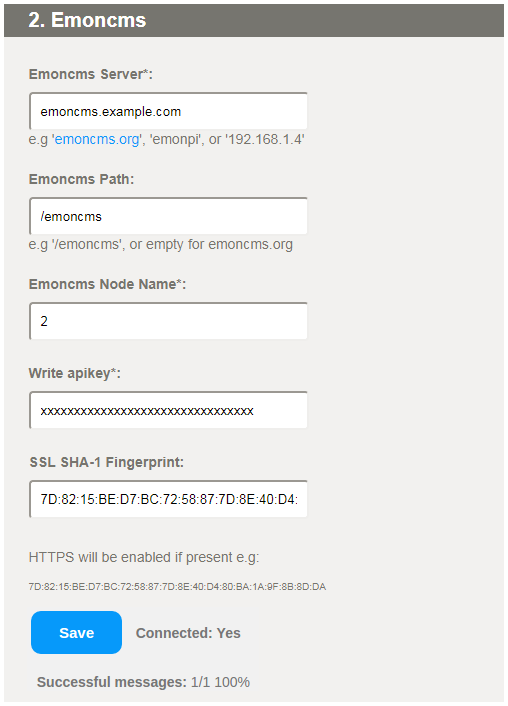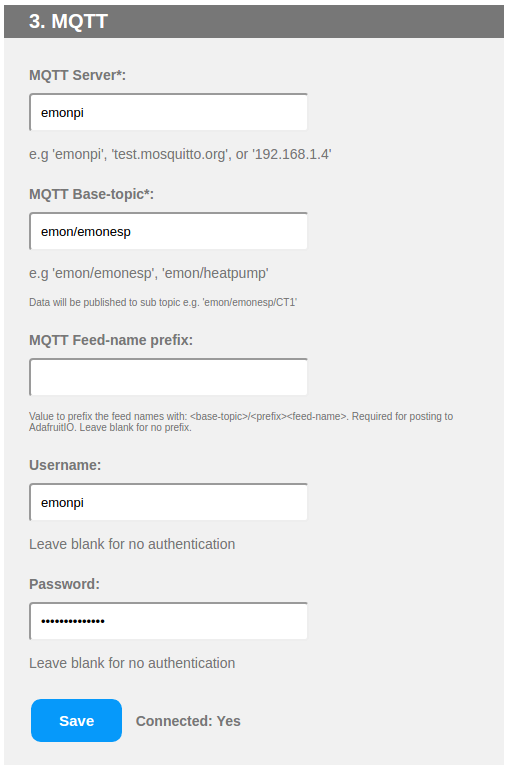ESP8266 WIFI serial to emoncms link
For applications that only require basic posting of data from one emonTx to a remote server such as Emoncms.org an emonTx with this WiFi module provides a lower cost route than an emonBase or emonPi base-station installation.
- Requirements
- User Guide
- ESP-12E module with 4M Flash
- Purchase a pre-loaded ESP8266
- To connect an ESP to emonTx see This User Guide Section
On first boot, ESP should broadcast a WiFI AP emonESP_XXX. Connect to this AP and the captive portal should forward you to the log-in page. If this does not happen navigate to http://192.168.4.1
Note: You may need to disable mobile data if connecting via a Android 6 device
- Select your WiFi network from list of available networks
- Enter WiFi PSK key then click
Connect
- emonESP should now connect to local wifi network and return local IP address.
- Browse to local IP address by clicking the hyperlink (assuming your computer is on the same WiFi network) On future boots EmonESP will automatically connect to this network.
Note: on some networks it's possible to browse to the EmonESP using hostname http://emonesp or on windows http://emonesp.local
If re-connection fails (e.g. network cannot be found) the EmonESP will automatically revert back to WiFi AP mode after a short while to allow a new network to be re-configued if required. Re-connection to existing network will be attempted every 5min.
Holding the boot button at startup (for about 10's) will force AP mode. This is useful when trying to connect the unit to a new WiFi network.
EmonESP can post data to emoncms.org or any other Emoncms server (e.g. emonPi) using Emoncms API.
In the Emoncms Server field, enter just the hostname or address without any path (e.g. emoncms.org), in the Emoncms Path field enter the path including the leading slash (e.g. /emoncms) or leave it empty if not required.
Data can be posted using HTTP or HTTPS. For HTTPS the Emoncms server must support HTTPS (emoncms.org does, emonPi does not). Due to the limited resources on the ESP the SSL SHA-1 fingerprint for the Emoncms server certificate must be manually entered and regularly updated.
Note: the emoncms.org fingerprint will change every 90 days when the SSL certificate is renewed.
To obtain the certificate fingerprint, you can use several methods, some examples:
- Chrome under Windows: click the secure icon next to the address bar and click on the certificate row to get the details, in the Details tab copy the hexadecimal digits from the box Thumbprint substituting spaces with colons and paying attention not to include any leading invisible character;
- Firefox under Linux: click the secure icon next to the address bar, Show connection details, More information, in the security tab click View Certificate and copy the SHA1 Fingerprint
- openssl under Linux: issue the following command substituting your host in place of www.example.com:
echo | openssl s_client -connect www.example.com:443 -servername www.example.com |& openssl x509 -fingerprint -sha1 -noout
EmonESP can post data to an MQTT server. Each data key:pair value will be published to a sub-topic of base topic.E.g data CT1:346 will results in 346 being published to <base-topic>/CT1
- Enter MQTT server host and base-topic
- (Optional) Enter server authentication details if required
- Click connect
- After a few seconds
Connected: Noshould change toConnected: Yesif connection is successful. Re-connection will be attempted every 10s.
Note: emon/xxxx should be used as the base-topic if posting to emonPi MQTT server if you want the data to appear in emonPi Emoncms. See emonPi MQTT docs.
HTTP Authentication (highly recomended) can be enabled by saving admin config by default username and password
HTTP authentication is required for all HTTP requests including input API
Displays free system memory and firmware version
TBC
http://<IP-ADDRESS>/status
Example return in JSON:
{"mode":"STA","networks":[],"rssi":[],"ssid":"OpenEnergyMonitor","srssi":"-58","ipaddress":"10.0.1.93","emoncms_server":"emoncms.org","emoncms_node":"emonesp","emoncms_apikey":"xxxxxxxx","emoncms_connected":"0","packets_sent":"0","packets_success":"0","mqtt_server":"emonpi","mqtt_topic":"emonesp","mqtt_user":"emonpi","mqtt_pass":"xxxxxx","mqtt_connected":"0","free_heap":"25040"}
Data can be inputed to EmonESP via serial UART or HTTP API.
Data in serial:pairs string format can be inputed to EmonESP via serial UART (115200 baud) e.g:
ct1:3935,ct2:325,t1:12.5,t2:16.9,t3:11.2,t4:34.7
Data in string:pairs can be sent to EmonESP via HTTP API. This is useful to emulate the serial string data function while using the UART for code upload and debug. API example:
http://<IP-ADDRESS>/input?string=ct1:3935,ct2:325,t1:12.5,t2:16.9,t3:11.2,t4:34.7
http://<IP-ADDRESS>/saveemoncms?&server=emoncms.org&apikey=xxxxxxxxxxxxxxxxxx&node=emonesp&fingerprint=7D:82:15:BE:D7:BC:72:58:87:7D:8E:40:D4:80:BA:1A:9F:8B:8D:DA
SSL SHA-1 fingerprint is optional, HTTPS connection will be enabled if present
http://<IP-ADDRESS>/savemqtt?&server=emonpi&topic=emonesp&user=emonpi&pass=emonpimqtt2016
MQTT user and pass are optional, leave blank for connection to un-authenticated MQTT servers
EmonESP uses ESP8266 core, Arduino framework
Firmware can be compiled and uploaded either using (PlatfomIO,) Arduino IDE, or flashed with pre-compiles binaries found in Releases using esptool.py.
Note different flash sizes of ESP12 module (4Mb) verses Sonoff devices (1Mb).
Use our emonupload tool to download latest pre-compiled firmware release and upload to EmonESP: https://github.com/openenergymonitor/emonupload
Find and Install esptool, python required. Navigate to the Releases section of the github page and get the firmware.bin and spiffs.bin files. Use the command below to flash the ESP.
esptool.py write_flash 0x0 ./firmware.bin
If you're having issues uploading try a slower baudrate, --baud 115200 is a failsafe option.
For more detailed ESP8266 Arduino core specific PlatfomIO notes see: https://github.com/esp8266/Arduino#using-platformio
The easiest way if running Linux is to install use the install script, this installs platformIO via python pip and installs pip if not present. See PlatformIO installation docs.
$ sudo python -c "$(curl -fsSL https://raw.githubusercontent.com/platformio/platformio/master/scripts/get-platformio.py)"
$ git clone https://github.com/openenergymonitor/EmonESP
$ cd EmonESP
$ pio run
The first time platformIO is run the espressif Arduino toolchain and all the required libs will be installed if required.
To compile EmonESP for sonoff s20 smartplugs, WIFI Relay and Heatpump Monitor specify the following environment:
$ pio run -e smartplug
$ pio run -e wifirelay
$ pio run -e hpmon
To compile for 4Mb esp12e modules use environment:
$ pio run -e esp12e
Put ESP into bootloader mode:
- For Adafruit HUZZAH press and hold
GPIO0button then press Reset, LED should light dimly to indicate bootloader mode. - For WiFi relay press and hold the reset button for the duration of the upload
- For Sonof S20 press the front button when connecting power
- On Heatpump monitor use jumper to pull
GPIO0low then reset then connect power (simulates reset) or pull RST pin low.
$ pio run -t upload
To compile and upload EmonESP for sonoff s20 smartplugs, WIFI Relay and Heatpump Monitor specify the following environment:
The default option without specifying any enviroment will upload to the Huzzah
$ pio run -t upload
$ pio run -e smartplug -t upload
$ pio run -e wifirelay -t upload
$ pio run -e hpmon -t upload
The ESP subsystems have a lot of logging that can be enabled via setting various build options.
Using Platform IO the easiest way to configure these is via the PLATFORMIO_BUILD_FLAGS environment variable.
First select the serial port to output debug;
-DDEBUG_ESP_PORT=Serial
-DDEBUG_ESP_PORT=Serial1
Then add one or more of the debug options;
-DDEBUG_ESP_CORE
-DDEBUG_ESP_WIFI
-DDEBUG_ESP_HTTP_CLIENT
-DDEBUG_ESP_HTTP_SERVER
-DDEBUG_ESP_HTTP_UPDATE
-DDEBUG_ESP_UPDATER
-DDEBUG_ESP_OTA
-DDEBUG_ESP_SSL
-DDEBUG_TLS_MEM
For example from the Windows Power shell you may do something like;
$env:PLATFORMIO_BUILD_FLAGS="-DDEBUG_ESP_PORT=Serial1 -DDEBUG_ESP_CORE -DDEBUG_ESP_WIFI"
pio run -t clean
pio run
pio run -t upload --upload-port 172.16.0.80
If you are experiencing ESP hanging in a reboot loop after upload it may be that the ESP flash has remnants of previous code (which may have the used the ESP memory in a different way). The ESP flash can be fully erased using esptool. With the unit in bootloder mode run:
$ esptool.py erase_flash
sudo maybe be required
Output:
esptool.py v1.2-dev
Connecting...
Running Cesanta flasher stub...
Erasing flash (this may take a while)...
Erase took 8.0 seconds
- https://community.openenergymonitor.org/t/emonesp-firmware-development/1191/43
- https://community.openenergymonitor.org/tags/emonesp
GNU V3 General Public License
